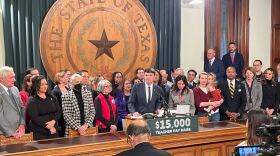Texas continues to lag behind other states when it comes to teacher pay, according to data the National Education Association released Monday.
The 2023 NEA Rankings and Estimates report shows the average salary for a public school teacher in the U.S. during the 2021-2022 school year was $66,745. The national average for the current school year is projected to be $68,469, an increase of 2.6%.
In Texas, which employs more teachers than any other state, the average salary during the last school year was $58,887. That figure is expected to be $60,716 this school year.
The data is troubling for Ovidia Molina, president of the Texas State Teachers Association.
“We continue to go in the wrong direction as a state in how to show our educators that we respect the profession, that we value the work that they do for the future of Texas,” she said.
NEA President Becky Pringle echoed Molina’s concern, noting that salary increases in Texas and the U.S., as a whole, are still not keeping pace with inflation.
“If we look at this year versus 2008," she said, "we see that adjusting for inflation, the average starting salary really is $5,000 less in terms of earning power than it was in 2008."
Pringle and Molina also pointed out that policymakers often focus on the need to increase starting salaries for new teachers to attract people to the field, especially as the number of college students who are going into education declines. But it’s also important to ensure veteran teachers are making more, too, they say.
Texas ranked 14th in the U.S. for the average starting teacher salary at $45,493 during the 2021-2022 school year — $2,648 higher than the national average.
But Texas falls behind significantly when it comes to salaries for experienced teachers. The average top salary for a Texas teacher is $64,739, which is more than $13,000 below the national average for a top teacher salary. Molina said the failure to adequately compensate veteran teachers can also be a deterrent for new teachers who do not see the field as sustainable.
“They know it's not going to be something that's going to take care of them once they are teaching more than five years, more than 10 years, and especially once they retire," she said, "because we also don't take care of our retired educators in the state."
Molina said the Texas Legislature, which has a nearly $33 billion budget surplus, is squandering its opportunity to meaningfully increase state funding for public education.

“[The funding] is nowhere near where it needs to be. It's nowhere near covering inflation, it's nowhere near making sure that our kids know that we value their education,” she said. “It's just ridiculous that we are taking this once in a lifetime opportunity and throwing it away when it comes to our kids.”
School districts throughout Texas have told lawmakers the basic allotment, which is the minimum amount the state must spend per student, needs to increase by more than $900 to keep up with inflation. The basic allotment is currently $6,160 per student and that figure has remained the same since 2019. Neither the Texas House nor the Senate has included anything close to that figure in its proposed budget for the next two years.
While the House on Wednesday will debate school finance legislation that would increase state funding for public education, it still does not make the investment advocates have been hoping for. House Bill 100 would, however, make a small increase to the basic allotment, increase the percentage of new revenue districts must spend on employee raises and shift the state’s school finance system from one based on attendance to one based on enrollment. But with about a month left in the legislative session, other measures to raise salaries, like HB 1548 from state Rep. James Talarico (D-Round Rock), have not yet gotten a committee hearing.
Pringle said local, state and federal officials need to be working on how to significantly increase teacher pay to keep educators in the classroom after years of disinvestment in public education. She said incremental salary increases are not going to cut it, especially because teachers’ jobs have become more complex in the wake of the pandemic as well as school shootings.
“We have to make sure that our school districts have what they need so they can offer competitive salaries," she said. "And we have to do it in a systemic way and in a way that it will be sustained."
Pringle also said it's key to address what’s known as the "wage penalty gap," which is the difference between what teachers earn and what people in professions that require a similar level of education earn. In Texas, teachers earn about 22% less than their counterparts.
“That means that when college students are looking at careers, they're going to look and make that comparison and say, ‘If I stay in college for this long, I know I can then make the kind of earnings I need to make or I could make in another career,'" she said. "So we have to address it systemically and we have to address it long term."
The NEA also found that teachers earn more in states that allow collective bargaining.
“So that's a strategy that can help us to raise those salaries," Pringle said.

While teachers in Texas do have the right to join a union, they do not have the right to collectively bargain.
Ultimately, Pringle said, there needs to be widespread recognition of and commitment to fixing the teacher shortage in the U.S.
“And we as a country, Texas as a state, we have got to step up in this moment and demonstrate that we see it and we're going to do something about it,” she said.













